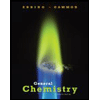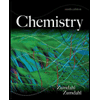
Concept explainers
For the reaction shown, calculate the theoretical yield of product in moles for each of the initial quantities of reactants.
a.
b.
c.
d.
Trending nowThis is a popular solution!
Learn your wayIncludes step-by-step video

Chapter 8 Solutions
Mastering Chemistry with Pearson eText -- Standalone Access Card -- for Introductory Chemistry (6th Edition)
Additional Science Textbook Solutions
Human Anatomy & Physiology (2nd Edition)
Anatomy & Physiology (6th Edition)
Biology: Life on Earth with Physiology (11th Edition)
Campbell Biology (11th Edition)
Applications and Investigations in Earth Science (9th Edition)
Chemistry: The Central Science (14th Edition)
- Deducing a rate law from the change in concentration over time To exit full screen, press and hold esc A chemistry graduate student is studying the rate of this reaction: H2CO3(aq) → H₂O(aq) +CO₂ (aq) - She fills a reaction vessel with H2CO3 and measures its concentration as the reaction proceeds: time (milliseconds) [H2CO3] 0 0.0500 M 10. 0.0266M 20. 0.0181 M 30. 0.0138M 40. 0.0111 M Use this data to answer the following questions. Write the rate law for this reaction. Calculate the value of the rate constant k. Round your answer to 2 significant digits. Also be sure your answer has the correct unit symbol. rate ☐ x10 k = Х 000 18 Ararrow_forwardWriting the rate law implied by a simple mechanism Suppose the formation of tert-butanol proceeds by the following mechanism: step elementary reaction 1 (CH3)3 CBr(aq) → (CH3)2 C* (aq) + Br (aq) 2 (CH3)2C (aq) + OH¯ (aq) → (CH3)2COH(aq) rate constant k₁ k₂ Suppose also k₁ »k2. That is, the first step is much faster than the second. Write the balanced chemical equation for the overall chemical reaction: Write the experimentally- observable rate law for the overall chemical reaction. Note: your answer should not contain the concentrations of any intermediates. rate = k ☐ Express the rate constant k for the overall chemical reaction in terms of K1, K2, and (if necessary) the rate constants k-1 and K-2 for the reverse of the two elementary reactions in the mechanism. k = ☐ □ ☑ G ? 00. 18 Ar Barrow_forwardDeducing a rate law from the change in concentration over time A chemistry graduate student is studying the rate of this reaction: 2SO3 (g) →>> 2SO2 (g) + O2(g) He fills a reaction vessel with SO3 and measures its concentration as the reaction proceeds: ? time (minutes) [SO3] 0 0.0200M 1.0 0.0105 M 2.0 0.00552M 3.0 0.00290M 4.0 0.00152M Use this data to answer the following questions. Write the rate law for this reaction. rate = k ☐ x10 Calculate the value of the rate constant k. Round your answer to 2 significant digits. Also be sure your answer has the correct unit symbol. k = ☐ Х 000 18 Ar BAarrow_forward
- Using the Arrhenius equation to calculate k at one temperature from k at... The rate constant of a certain reaction is known to obey the Arrhenius equation, and to have an activation energy E reaction is 1.2 × 107 M −1 .S at 160.0 °C, what will the rate constant be at 194.0 °C? Round your answer to 2 significant digits. k = Шм −1 -1 .S ☐ x10 ☑ 5 = = 16.0 kJ/mol. If the rate constant of this a ? olo Ar Barrow_forwardUsing the Arrhenius equation to calculate k at one temperature from k at... a The rate constant of a certain reaction is known to obey the Arrhenius equation, and to have an activation energy E = 10.0 kJ/mol. If the rate constant of this reaction is 9.9 × 107 M -1 .S at 246.0 °C, what will the rate constant be at 196.0 °C? Round your answer to 2 significant digits. k = ☐ M -1 −1 .S x10 ☑ ? 00. 18 Ar Barrow_forwardWriting the rate law implied by a simple mechanism Suppose the reaction between nitric oxide and bromine proceeds by the following mechanism: elementary reaction - NO(g) + Br2(g) → NOBг2(g) step 1 2 NOBг2(g) + NO(g) - rate constant k₁ 2 NOBr(g) k2 Suppose also k₁ »k2. That is, the first step is much faster than the second. Write the balanced chemical equation for the overall chemical reaction: Write the experimentally- observable rate law for the overall chemical reaction. Note: your answer should not contain the concentrations of any intermediates. ☐ rate = k Express the rate constant k for the overall chemical reaction in terms of k₁, k2, and (if necessary) the rate constants k-1 and K-2 for the reverse of the two elementary reactions in the mechanism. = ☐ ロ→ロ Х ك ? 000 18 Ararrow_forward
- Deducing a rate law from the change in concentration over time chemistry graduate student is studying the rate of this reaction: 2H3PO4 (aq) → P₂O5 (aq) +3H₂O (aq) 2 e fills a reaction vessel with H3PO and measures its concentration as the reaction proceeds: 4 time (seconds) [H3PO4] 0 0.500M 1.0 0.229 M 2.0 0.148M 3.0 0.110M 4.0 0.0871 M se this data to answer the following questions. Write the rate law for this reaction. rate = k x10 Calculate the value of the rate constant k. k = Round your answer to 2 significant digits. Also be sure your answer has the correct unit symbol. ☑ G olo 18 Ararrow_forwardWriting the rate law implied by a simple mechanism Suppose the formation of nitrosyl chloride proceeds by the following mechanism: elementary reaction step rate constant 1 NO(g) + Cl2(g) → NOC₁₂(g) k₁ 2 NOCl2(g) + NO(g) 2 NOCl(g) →>> k2 Suppose also k₁ »k. That is, the first step is much faster than the second. Write the balanced chemical equation for the overall chemical reaction: Write the experimentally- observable rate law for the overall chemical reaction. rate = k ☐ Note: your answer should not contain the concentrations of any intermediates. Express the rate constant k for the overall chemical reaction in terms of K1, K2, and (if necessary) the rate constants k-1 and K-2 for the reverse of the two elementary reactions in the mechanism. k = | Х ? 18 Ararrow_forwardUsing first- and second-order integrated rate laws 1/5 Consider this reaction: H2CO3(aq) → H₂O (aq) +CO₂ (aq) At a certain temperature it obeys this rate law. rate = (2.27 s¹) [H2CO3] Suppose a vessel contains H2CO3 at a concentration of 0.830M. Calculate how long it takes for the concentration of H2CO3 to decrease by 83.0%. You may assume no other reaction is important. Round your answer to 2 significant digits. S x10 ☑ § ? 00. 18 Ararrow_forward
- Using the Arrhenius equation to calculate k at one temperature from k at... Try Again Your answer is incorrect. 0/5 a The rate constant of a certain reaction is known to obey the Arrhenius equation, and to have an activation energy E = 28.0 kJ/mol. If the rate constant of this -1 -1 reaction is 2.5 × 10³ M ·S at 45.0 °C, what will the rate constant be at 104.0 °C? Round your answer to 2 significant digits. ST -1 -1 ☐ x10 k = 2.8 × 10 - M .S 18 Ararrow_forwardIn the theory of the state of transition, indicate the expression of the constant k in function of deltaE0#. This expression is also the ecuation of Arrhenius?arrow_forwardBriefly indicate the differences between Ea of the theory of collisions and E0# the theory of the state of transition.arrow_forward
 Chemistry: The Molecular ScienceChemistryISBN:9781285199047Author:John W. Moore, Conrad L. StanitskiPublisher:Cengage Learning
Chemistry: The Molecular ScienceChemistryISBN:9781285199047Author:John W. Moore, Conrad L. StanitskiPublisher:Cengage Learning Chemistry for Engineering StudentsChemistryISBN:9781337398909Author:Lawrence S. Brown, Tom HolmePublisher:Cengage Learning
Chemistry for Engineering StudentsChemistryISBN:9781337398909Author:Lawrence S. Brown, Tom HolmePublisher:Cengage Learning General Chemistry - Standalone book (MindTap Cour...ChemistryISBN:9781305580343Author:Steven D. Gammon, Ebbing, Darrell Ebbing, Steven D., Darrell; Gammon, Darrell Ebbing; Steven D. Gammon, Darrell D.; Gammon, Ebbing; Steven D. Gammon; DarrellPublisher:Cengage Learning
General Chemistry - Standalone book (MindTap Cour...ChemistryISBN:9781305580343Author:Steven D. Gammon, Ebbing, Darrell Ebbing, Steven D., Darrell; Gammon, Darrell Ebbing; Steven D. Gammon, Darrell D.; Gammon, Ebbing; Steven D. Gammon; DarrellPublisher:Cengage Learning ChemistryChemistryISBN:9781305957404Author:Steven S. Zumdahl, Susan A. Zumdahl, Donald J. DeCostePublisher:Cengage Learning
ChemistryChemistryISBN:9781305957404Author:Steven S. Zumdahl, Susan A. Zumdahl, Donald J. DeCostePublisher:Cengage Learning Chemistry: An Atoms First ApproachChemistryISBN:9781305079243Author:Steven S. Zumdahl, Susan A. ZumdahlPublisher:Cengage Learning
Chemistry: An Atoms First ApproachChemistryISBN:9781305079243Author:Steven S. Zumdahl, Susan A. ZumdahlPublisher:Cengage Learning





